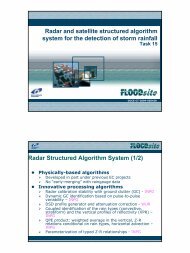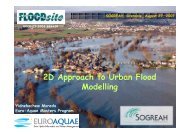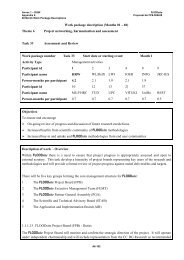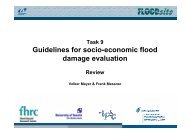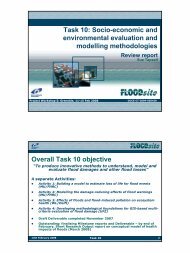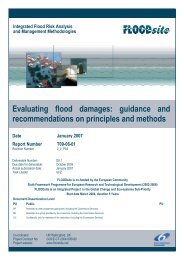Evacuation and traffic management (full report) - FLOODsite
Evacuation and traffic management (full report) - FLOODsite
Evacuation and traffic management (full report) - FLOODsite
Create successful ePaper yourself
Turn your PDF publications into a flip-book with our unique Google optimized e-Paper software.
Task 17 <strong>Evacuation</strong> D17-1<br />
Contract No:GOCE-CT-2004-505420<br />
2.4.2 Emergency flood <strong>management</strong><br />
In this chapter the procedures <strong>and</strong> sequence in the case of a major flood event are illustrated.<br />
Emergency flood <strong>management</strong> is organised <strong>and</strong> accomplished by the lower disaster protection<br />
authorities that are the rural <strong>and</strong> urban districts, the measures to be implemented are described with<br />
two examples related to the City of Dresden as the capital of Saxony <strong>and</strong> the City of Cologne as the<br />
biggest city of North Rhine-Westphalia.<br />
City of Dresden <strong>and</strong> Saxony<br />
Flood warnings for Dresden are the responsibility of the lower water authority. There are four<br />
warning phases per water level gauge <strong>and</strong> every phase characterises a certain situation of an<br />
emergency which necessitates certain measures:<br />
• Alert phase 1: Announcement service<br />
• Alert phase 2: Controlling service<br />
• Alert phase 3: Guarding service<br />
• Alert phase 4: Flood defence.<br />
As soon as the alert phase 3 has been activated (at a water level of 6.00 m for the Elbe River in<br />
Dresden) <strong>and</strong> alert phase 4 is expected (water level 7.00 m) the lower disaster protection authority<br />
declares “disaster pre-alarm”. If these conditions are fulfilled the disaster alarm can be activated<br />
which means that the fire brigade now has authority over the private aid organisations. Whilst the<br />
activation of disaster pre-alarm is compulsory, the activation of disaster alarm is not. However, it is<br />
possible to activate disaster alarm after the time alert phase 4 has been achieved (cf. SächsKatSVO §<br />
9).<br />
The basic plans for emergency flood <strong>management</strong> in Dresden are disaster protection maps, alarm, <strong>and</strong><br />
operational maps. The disaster protection maps are used from the time disaster pre-alarm has been<br />
activated. The alarm maps are configured as registers <strong>and</strong> contain an array of information for different<br />
working groups. Well before the beginning of a flood event the operational plans are used. These<br />
plans contain general guidelines for planning <strong>and</strong> are for instance available from the fire brigades.<br />
The disaster protection plan <strong>and</strong> alarm plan maps are also available from the Management System<br />
DISMA (cf. chapter 3). In Dresden the maps neither describe processes nor do they include any ‘ifthen-guidelines’,<br />
but they can be seen as databanks, including information on emergency flood<br />
<strong>management</strong> (Survey of the Department Order <strong>and</strong> Safety Dresden).<br />
In case of an emergency flood event two special units operate. The first one is an operational <strong>and</strong><br />
tactical guiding unit. The second one is the administrative organisational unit, the so-called<br />
administration guiding device (§ 5 KatSG Sachsen). The members of these units take up employment<br />
from the time disaster pre-alarm is activated.<br />
Before any measures can be implemented the necessary decisions have to be made. The technical<br />
authorities (e.g. the water authorities, environmental departments) assess the situation based upon<br />
online data <strong>and</strong> onsite inspections. The appraisal is put forward to the administration unit which that<br />
assesses the available information <strong>and</strong> is responsible for decision making. Most of the measures that<br />
have to be implemented are dependent on the situation. Examples for important measures are as<br />
follows:<br />
• Filling <strong>and</strong> distribution of s<strong>and</strong> bags for common needs (Responsibility: Department for Fire<br />
Control <strong>and</strong> Disaster Protection);<br />
• Establishment of mobile protection walls by using maps that include water levels in half meter<br />
steps (Responsibility: Department for Fire Control <strong>and</strong> Disaster Protection)<br />
• Closure of infrastructure <strong>and</strong> beginning of <strong>traffic</strong> diversions (Responsibility: Department for Road<br />
Engineering);<br />
• Establishment of temporary flood defences;<br />
T17_07_02_<strong>Evacuation</strong>_<strong>and</strong>_<strong>traffic</strong>_<strong>management</strong>_D17_1_V4_4_P01.doc 19 03 2008<br />
32




